ECO mode Citroen C4 PICASSO RHD 2013 1.G User Guide
[x] Cancel search | Manufacturer: CITROEN, Model Year: 2013, Model line: C4 PICASSO RHD, Model: Citroen C4 PICASSO RHD 2013 1.GPages: 420, PDF Size: 9.66 MB
Page 62 of 420
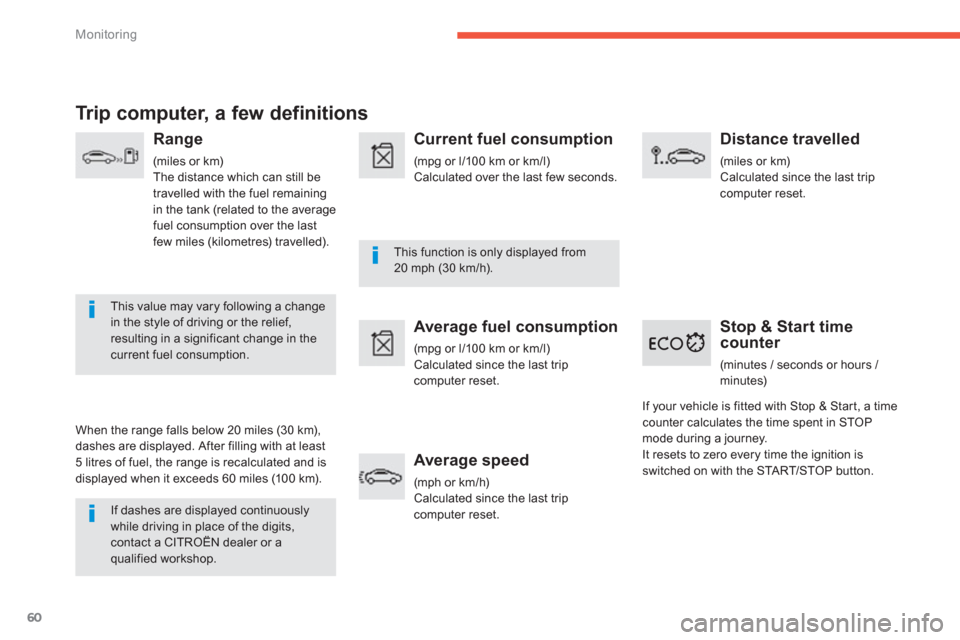
60
Monitoring
Tr ip computer, a few definitions
Range
(miles or km)
The distance which can still be
travelled with the fuel remainingin the tank (related to the average fuel consumption over the last few miles (kilometres) travelled).
This value may vary following a changein the style of driving or the relief,resulting in a significant change in thecurrent fuel consumption.
When the ran
ge falls below 20 miles (30 km),
dashes are displayed. After filling with at least 5 litres of fuel, the range is recalculated and is
displayed when it exceeds 60 miles (10 0 km).
If dashes are displayed continuously while driving in place of the digits,
contact a CITROËN dealer or a qualified workshop.
This function is only displayed from 20 mph (30 km/h).
Current fuel consumption
(mpg or l/100 km or km/l) Calculated over the last few seconds.
Average fuel consumption
(mpg or l/100 km or km/l) Calculated since the last trip computer reset.
Average speed
(mph or km/h)Calculated since the last trip computer reset.
Distance travelled
(miles or km)
Calculated since the last trip
computer reset.
Stop & Start time counter
(minutes / seconds or hours /
minutes)
If your vehicle is fitted with Stop & Star t, a timecounter calculates the time spent in STOP mode during a journey.
It resets to zero every time the ignition isswitched on with the STA R T/STOP button.
Page 104 of 420
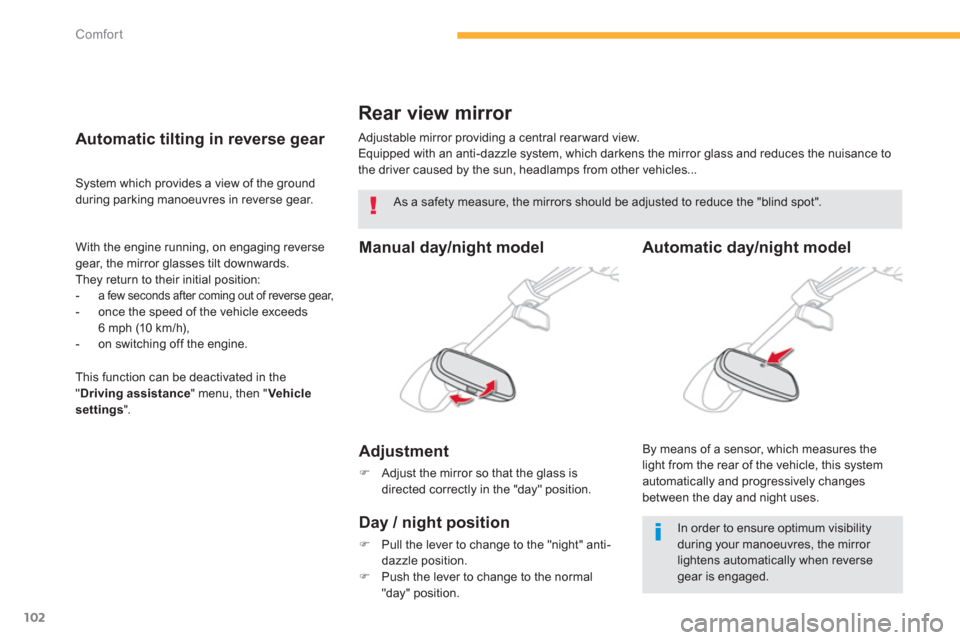
102
Comfort
Rear view mirror
Adjustable mirror providing a central rearward view.
Equipped with an anti-dazzle system, which darkens the mirror glass and reduces the nuisance to
the driver caused b
y the sun, headlamps from other vehicles...
Manual day/night model
Ad
justment
�)
Adjust the mirror so that the glass is
directed correctly in the "day" position.
As a safety measure, the mirrors should be adjusted to reduce the "blind spot".
In order to ensure optimum visibilityduring your manoeuvres, the mirror lightens automatically when reversegear is engaged.
Day / night position
�)
Pull the lever to change to the "night" anti-dazzle position.�)
Push the lever to change to the normal "day" position.
Automatic day/night model
By means of a sensor, which measures the
light from the rear of the vehicle, this system
automatically and progressively changes
between the day and night uses.
Automatic tilting in reverse gear
With the engine running, on engaging reversegear, the mirror glasses tilt downwards.
They return to their initial position:
-a few seconds after coming out of reverse gear, - once the speed of the vehicle exceeds6 mph (10 km/h),
- on switching off the engine.
S
ystem which provides a view of the ground
during parking manoeuvres in reverse gear.
Thi
s function can be deactivated in the"Driving assistance" menu, then " Vehicle
settings".
Page 111 of 420
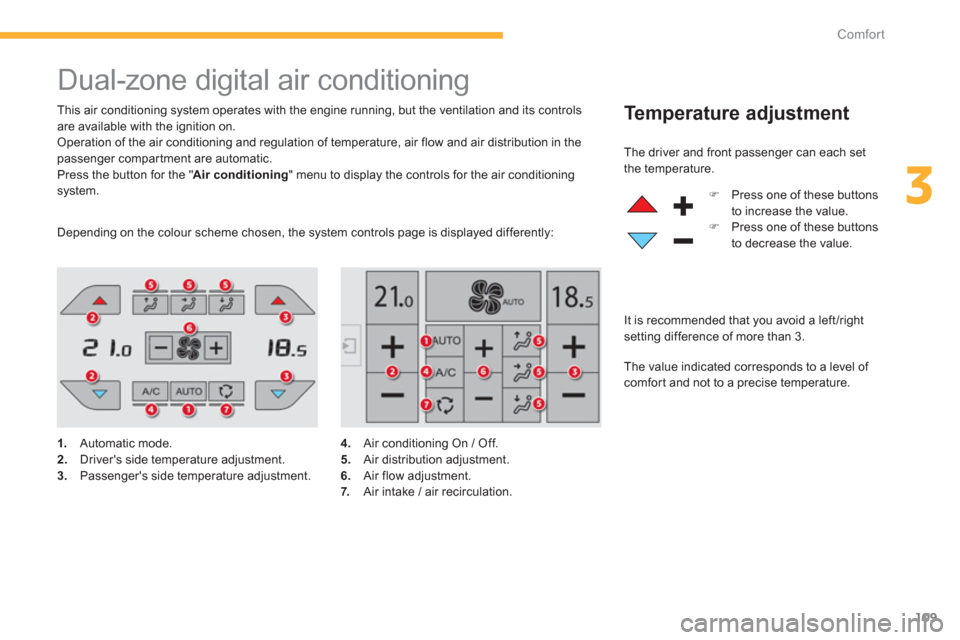
109
3
Comfort
Dual-zone digital air conditioning
This air conditioning system operates with the engine running, but the ventilation and its controls
are available with the ignition on.
Operation of the air conditioning and regulation of temperature, air flow and air distribution in the passenger compartment are automatic.
Press the button for the " Air conditioning" menu to display the controls for the air conditioningsystem.
Temperature adjustment
1.
Automatic mode. 2.Driver's side temperature adjustment.3.Passenger's side temperature adjustment. The driver and
front passenger can each set
t
he temperature.
�)Press one of these buttons
to increase the value.
�)Press one of these buttons
to decrease the value.
The value indicated corresponds to a level of
comfor t and not to a precise temperature.
It is recommended that
you avoid a left /right setting difference of more than 3.
Dependin
g on the colour scheme chosen, the system controls page is displayed differently:
4.
Air conditioning On / Off.
5. Air distribution adjustment.6.
Air flow adjustment. 7.
Air intake / air recirculation.
Page 112 of 420
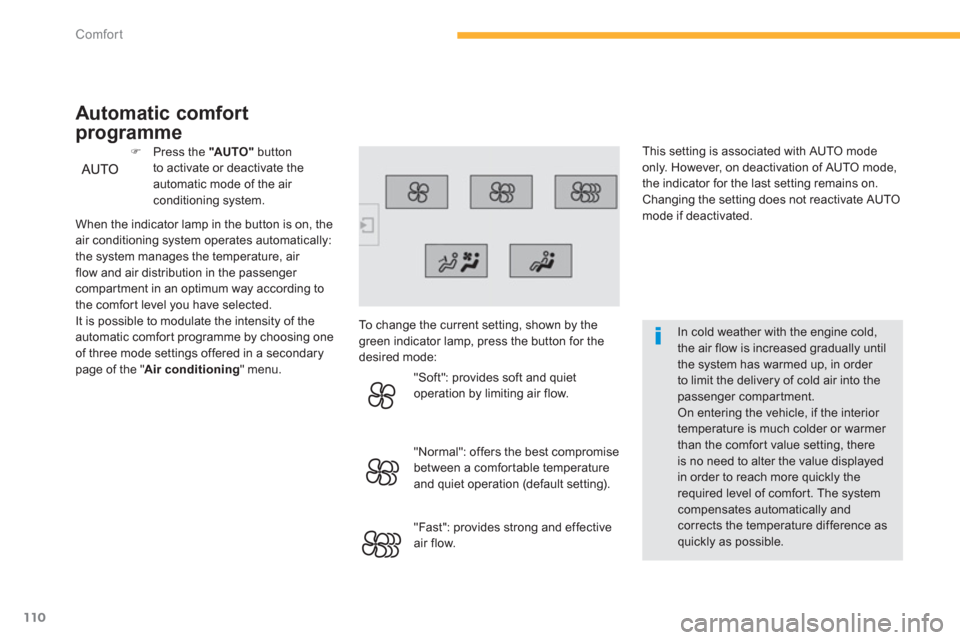
110
Comfort
In cold weather with the engine cold, the air flow is increased gradually until the system has warmed up, in order to limit the delivery of cold air into the passenger compartment. On entering the vehicle, if the interior temperature is much colder or warmer than the comfort value setting, thereis no need to alter the value displayed in order to reach more quickly therequired level of comfort. The systemcompensates automatically andcorrects the temperature difference as quickly as possible.
This settin
g is associated with AUTO mode
only. However, on deactivation o
f AUTO mode,
the indicator for the last setting remains on.
Changing the setting does not reactivate AUTO mode if deactivated.
When the indicator lamp in the button is on, the
air conditioning system operates automatically:
the system manages the temperature, air flow and air distribution in the passenger compartment in an optimum way according to
the comfor t level you have selected.
It is possible to modulate the intensity of the automatic comfort programme by choosing one
of three mode settings offered in a secondary page of the " Air conditioning " menu.
�)
Press the "AUTO"
button
to activate or deactivate the automatic mode of the air conditioning system.
Automatic comfort
programme
To c h a nge the current setting, shown by the green indicator lamp, press the button for thedesired mode:
"Soft": provides soft and quiet
operation b
y limiting air flow.
"Normal": offers the best compromise
between a com
fortable temperature
and quiet operation (default setting).
"Fast": provides stron
g and effective air flow.
Page 142 of 420
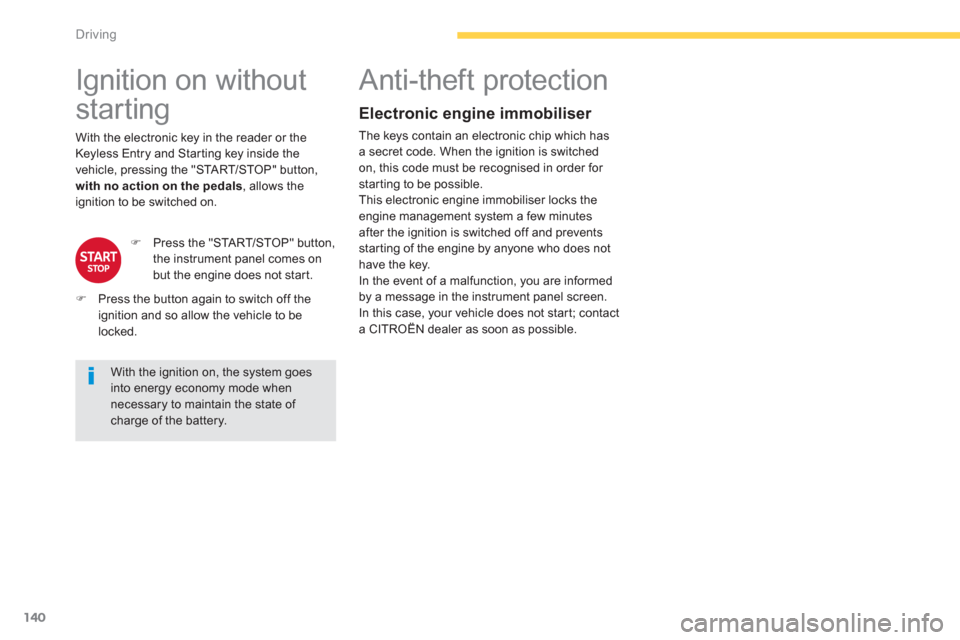
140
Driving
Ignition on without
starting
With the ignition on, the system goes into energy economy mode whennecessary to maintain the state of charge of the battery. With the electronic key in the reader or the
Keyless Entry and Starting key inside the
vehicle, pressin
g the "START/STOP" button,
with no action on the pedals
, allows the
ignition to be switched on.
�)
Press the "START/STOP" button,the instrument panel comes onbut the engine does not star t.
�)Press the button again to switch off the ignition and so allow the vehicle to belocked.
Anti-theft protection
Electronic engine immobiliser
The keys contain an electronic chip which has
a secret code. When the ignition is switched
on, this code must be recognised in order for
starting to be possible.
This electronic engine immobiliser locks the
engine management system a few minutes
after the ignition is switched off and prevents
starting of the engine by anyone who does not
have the key.
In the event of a malfunction, you are informedby a message in the instrument panel screen.
In this case, your vehicle does not start; contact
a CITROËN dealer as soon as possible.
Page 143 of 420
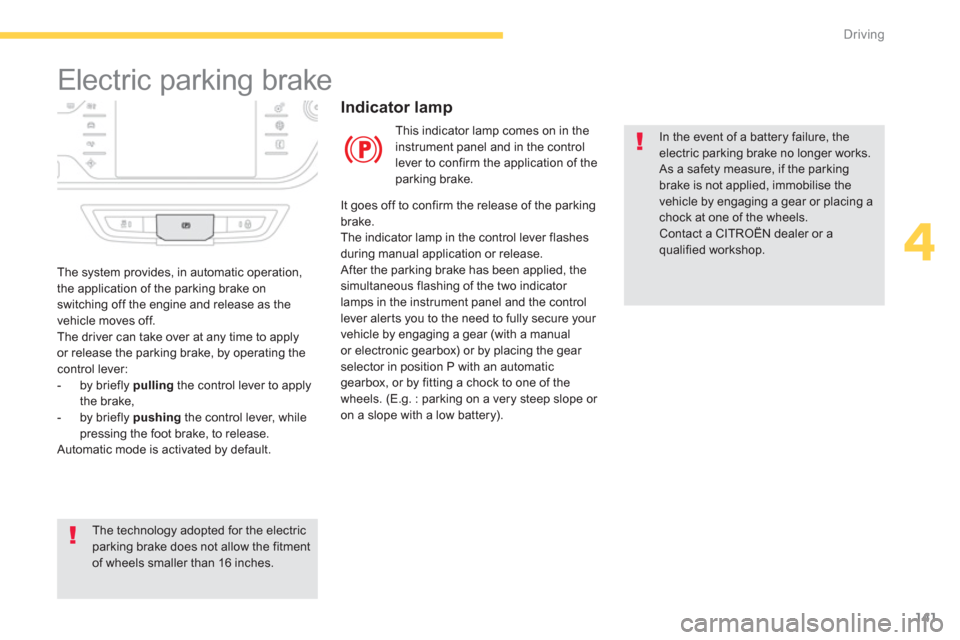
141
4
Driving
Electric parking brake
In the event of a battery failure, theelectric parking brake no longer works.
As a safety measure, if the parking brake is not applied, immobilise thevehicle by engaging a gear or placing achock at one of the wheels. Contact a CITROËN dealer or a qualified workshop.
Indicator lamp
This indicator lamp comes on in theinstrument panel and in the control
lever to con
firm the application of the
parking brake.
The s
ystem provides, in automatic operation,
the application of the parking brake onswitching off the engine and release as the
vehicle moves off.
The driver can take over at any time to apply
or release the parking brake, by operating thecontrol lever:
- by briefly pullingthe control lever to applythe brake,
- by briefly pushing
the control lever, while pressing the foot brake, to release.
Automatic mode is activated by default.
The technology adopted for the electric
parking brake does not allow the fitmentof wheels smaller than 16 inches.It
goes off to confirm the release of the parkingbrake.
The indicator lamp in the control lever flashes
durin
g manual application or release.
After the parking brake has been applied, the
simultaneous flashing of the two indicator lamps in the instrument panel and the control lever alerts you to the need to fully secure your
vehicle by engaging a gear (with a manual
or electronic gearbox) or by placing the gear
selector in position P with an automatic
gearbox, or by fitting a chock to one of the wheels. (E.g. : parking on a very steep slope or
on a slope with a low battery).
Page 153 of 420
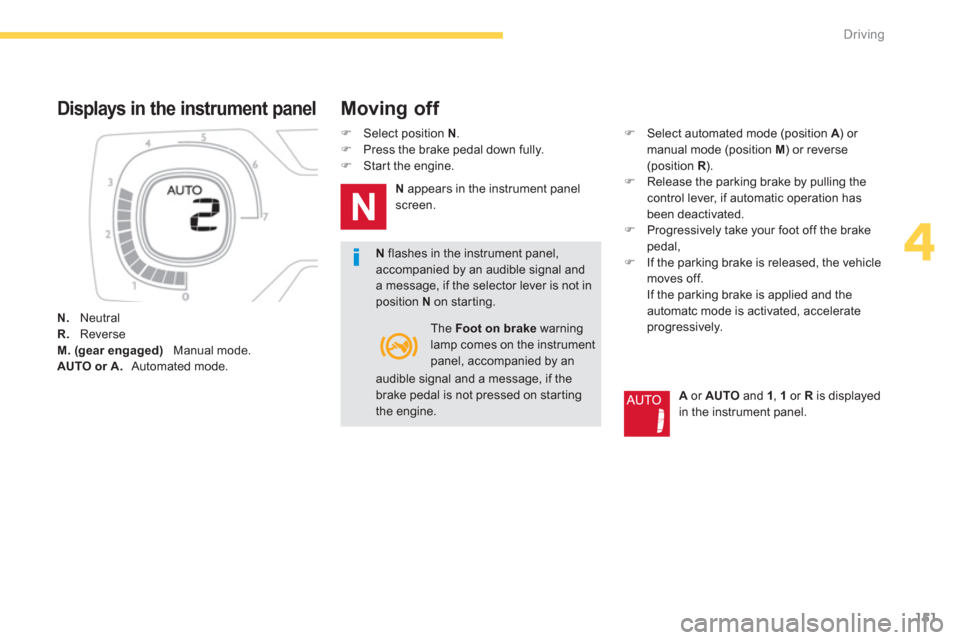
151
4
Driving
Displays in the instrument panel
N.
Neutral
R.ReverseM.(gear engaged)Manual mode.
AUTO or A.Automated mode.
Nflashes in the instrument panel,accompanied by an audible signal anda message, if the selector lever is not in position N on starting.
Moving off
�)
Select position N.�)
Press the brake pedal down fully.
�)
Start the engine.
Nappears in the instrument panelscreen.
�)
Select automated mode (position A) or Amanual mode (position M) or reverse
(position R
). R�)
Release the parking brake by pulling thecontrol lever, if automatic operation hasbeen deactivated. �)
Progressively take your foot off the brake pedal,�)
If the parking brake is released, the vehicle moves off.
If the parking brake is applied and the
automatc mode is activated, accelerate
progressively.
A or AUTO
and 1, 1
or Ris displayed
in the instrument panel.
The Foot on brakewarning lamp comes on the instrument panel, accompanied by an
audible signal and a message, if the brake pedal is not pressed on star ting the engine.
Page 159 of 420
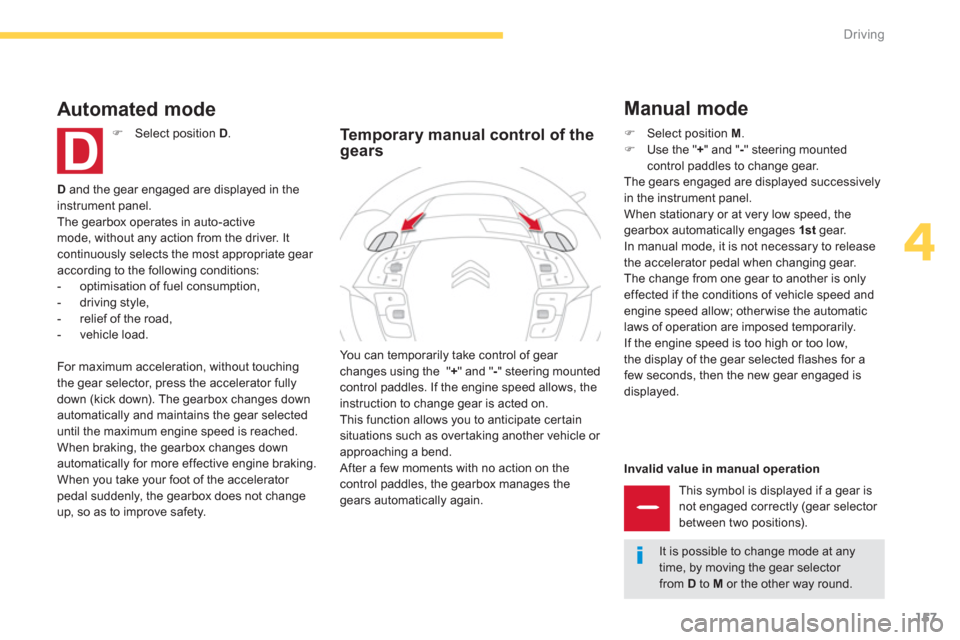
157
4
Driving
Invalid value in manual operation
This symbol is displayed i
f a gear is not engaged correctly (gear selector
between two positions). You can temporaril
y take control of gear changes using the "+
" and "-" steering mounted control paddles. If the engine speed allows, the
instruction to change gear is acted on.
This function allows you to anticipate cer tain situations such as overtaking another vehicle or
approaching a bend.
After a few moments with no action on the control paddles, the gearbox manages thegears automatically again.
Te m p o r a ry manual control of the gears
Manual mode
Dand the gear engaged are displayed in the instrument panel.
The gearbox operates in auto-active
mode, without any action from the driver. It continuously selects the most appropriate gear
according to the following conditions:
- optimisation of fuel consumption,
- drivin
g style,
- relief of the road,
- vehicle load.
Automated mode
�)
Select position D.
For maximum acceleration, without touching
the gear selector, press the accelerator fully
down (kick down). The gearbox changes down
automatically and maintains the gear selected
until the maximum en
gine speed is reached.
When braking, the gearbox changes down
automatically for more effective engine braking.
When you take your foot of the accelerator pedal suddenly, the gearbox does not change
up, so as to improve safety.
�) Select position M.�)
Use the " + " and "- " steering mounted
control paddles to change gear.
The gears engaged are displayed successively
in the instrument panel.
When stationar
y or at very low speed, the gearbox automatically engages 1st
gear.
In manual mode, it is not necessary to release
the accelerator pedal when changing gear.
The change from one gear to another is onlyeffected if the conditions of vehicle speed andengine speed allow; other wise the automatic
laws of operation are imposed temporarily.
If the engine speed is too high or too low,
the display of the gear selected flashes for a few seconds, then the new gear engaged is displayed.
It is possible to change mode at any time, by moving the gear selector from D
to Mor the other way round.
Page 160 of 420

158
Driving
Before switching off the engine, you canchange to position P or Nto be in neutral.
In either case, appl
y the parking brake to
immobilise the vehicle, unless it is programmed
in automatic mode.
If the lever is not in position P, on opening the Pdriver's door or approximately 45 seconds after switching off the ignition there is an audible signal and a message appears: �)move the gear selector to position P; the audible signal stops and the message
disappears.
Operating fault
Whenever parking, you must apply the parking
brake to immobilise the vehicle, if automatic
operation has been deactivated.
Parking the vehicle
In all circumstances, ensure that thegear selector is in position Pbefore leaving your vehicle.In th
e event of a fault with the
gearbox, the ser vice warning lamp
comes on in the instrument panel, accompanied by a message and anaudible signal.
In this case the gearbox goes into back-up
mode and stays in 3rdgear. You may then feel
a noticeable jolt when going from P to Rand from N
to R
. This jolt does not present any risk
to the gearbox.
Do not exceed 60 mph (10 0 km/h) while also
observing legal speed limits.
Have it checked by a CITROËN dealer or aqualified workshop.
Page 161 of 420
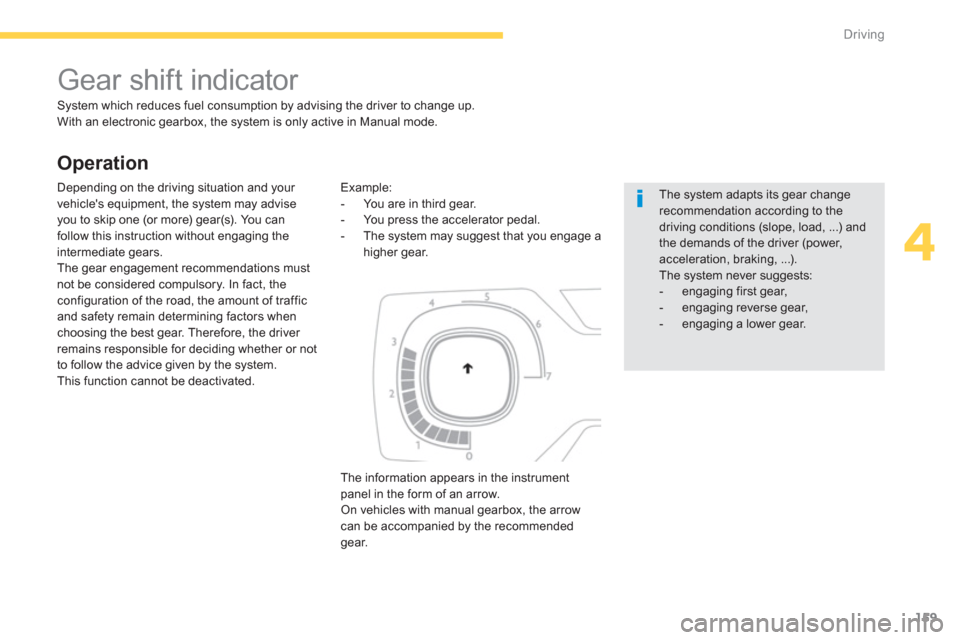
159
4
Driving
Operation
Gear shift indicator
System which reduces fuel consumption by advising the driver to change up.
With an electronic gearbox, the system is only active in Manual mode.
The system adapts its gear change recommendation according to thedriving conditions (slope, load, ...) and the demands of the driver (power,acceleration, braking, ...).
The system never suggests:
- engaging first gear,
- engaging reverse gear,
- engaging a lower gear.
Example:
- You are in third gear.
- Yo u press the accelerator pedal.
- The s
ystem may suggest that you engage a
higher gear.
The in
formation appears in the instrumentpanel in the form of an arrow. On vehicles with manual gearbox, the arrowcan be accompanied by the recommended gear.
Depending on the driving situation and your
vehicle's equipment, the system may advise
you to skip one (or more) gear(s). You can
follow this instruction without engaging the
intermediate gears.
The gear engagement recommendations mustnot be considered compulsory. In fact, the configuration of the road, the amount of traffic
and safety remain determining factors whenchoosing the best gear. Therefore, the driver
remains responsible for deciding whether or not
to follow the advice given by the system.
This function cannot be deactivated.